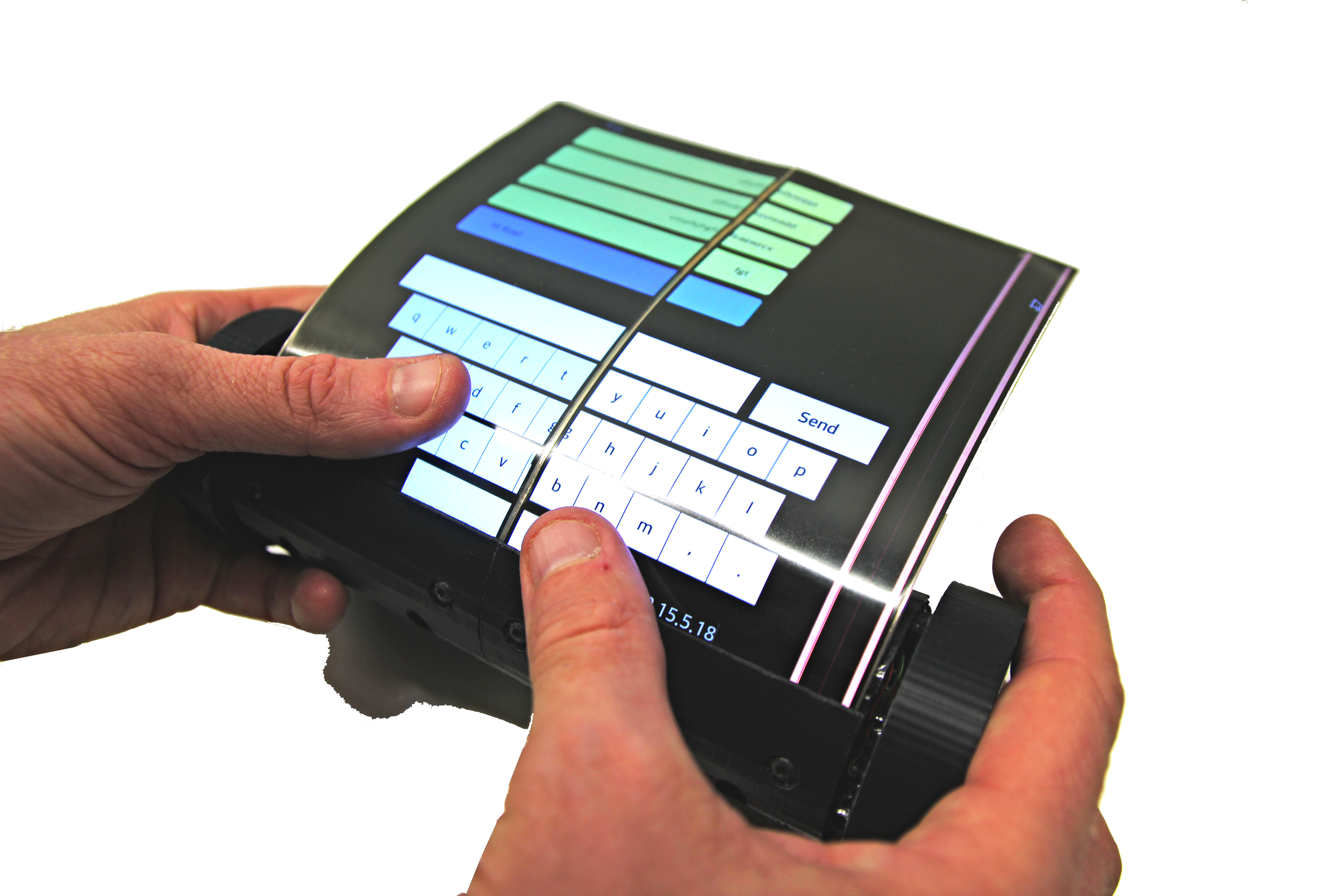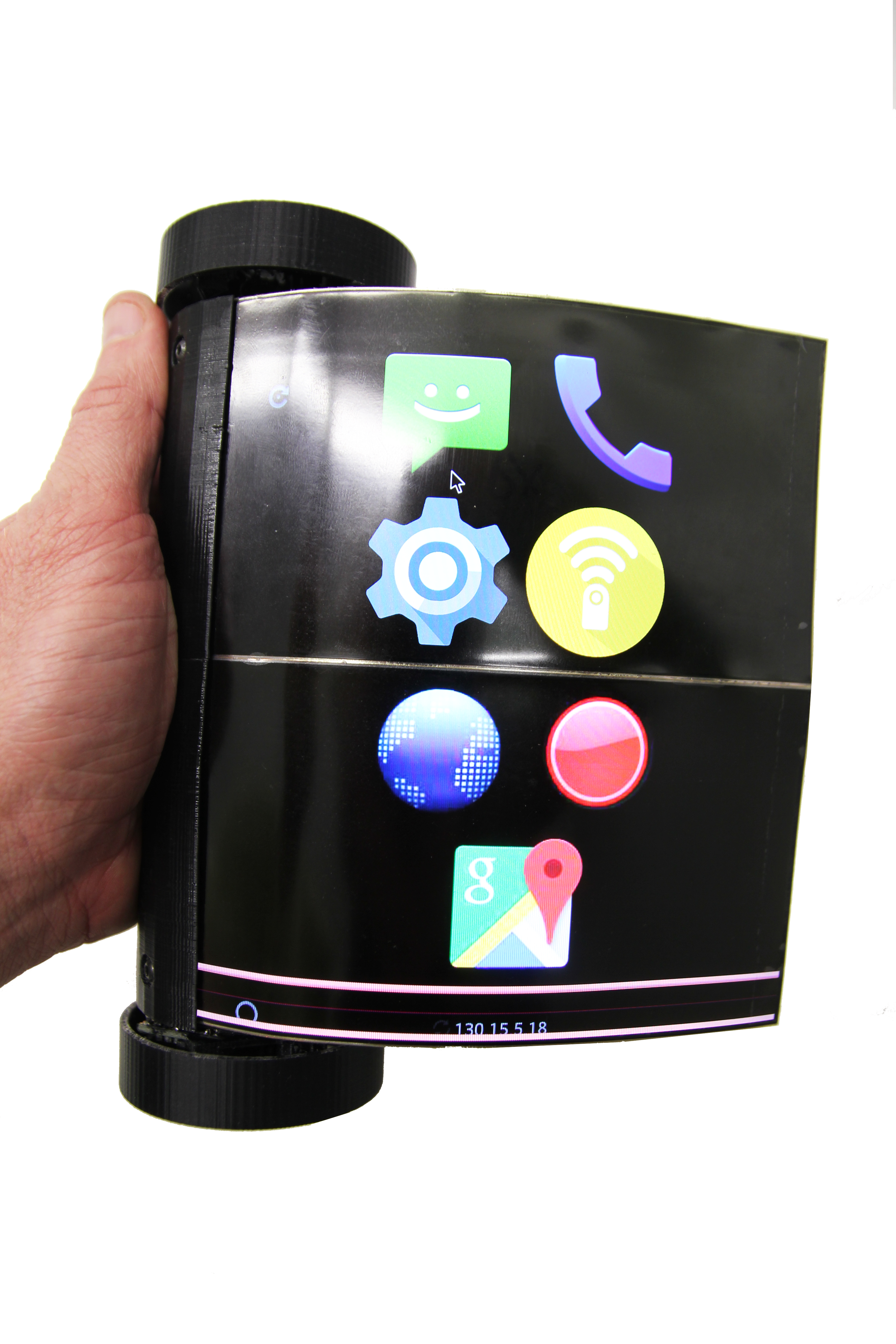Queen’s Human Media Lab unveils the world's first rollable touch-screen tablet, inspired by ancient scrolls
BARCELONA - A Queen’s University research team has taken a page from history, rolled it up and created the MagicScroll – a rollable touch-screen tablet designed to capture the seamless flexible screen real estate of ancient scrolls in a modern-day device. Led by bendable-screen pioneer Dr. Roel Vertegaal, this new technology is set to push the boundaries of flexible device technology into brand new territory.
The device is comprised of a high-resolution, 7.5” 2K resolution flexible display that can be rolled or unrolled around a central, 3D-printed cylindrical body containing the device’s computerized inner-workings. Two rotary wheels at either end of the cylinder allow the user to scroll through information on the touch screen. When a user narrows in on an interesting piece of content that they would like to examine more deeply, the display can be unrolled and function as a tablet display. Its light weight and cylindrical body makes it much easier to hold with one hand than an iPad. When rolled up, it fits your pocket and can be used as a phone, dictation device or pointing device.
“We were inspired by the design of ancient scrolls because their form allows for a more natural, uninterrupted experience of long visual timelines,” says Dr. Vertegaal, Professor of Human-Computer Interaction and Director of the Queen’s University Human Media Lab. Another source of inspiration was the old rolodex filing systems that were used to store and browse contact cards. The MagicScroll’s scroll wheel allows for infinite scroll action for quick browsing through long lists. Unfolding the scroll is a tangible experience that gives a full screen view of the selected item. Picture browsing through your Instagram timeline, messages or LinkedIn contacts this way!”
Beyond the innovative flexible display, the prototype also features a camera that allows users to employ the rolled-up MagicScroll as a gesture-based control device – similar to that of Nintendo’s ‘Wiimote’. And the device’s rotary wheels contain robotic actuators that allow the device to physically move or spin in place in various scenarios, like when it receives a notification for instance.
“Eventually, our hope is to design the device so that it can even roll into something as small as a pen that you could carry in your shirt pocket,” says Dr. Vertegaal. “More broadly, the MagicScroll project is also allowing us to further examine notions that ‘screens don’t have to be flat’ and ‘anything can become a screen’. Whether it’s a reusable cup made of an interactive screen on which you can select your order before arriving at a coffee-filling kiosk, or a display on your clothes, we’re exploring how objects can become the apps.
Dr. Vertegaal’s Human Media Lab collaborator Juan Pablo Carrascal will be presenting MagicScroll at MobileHCI, one of the leading international conferences on Human-Computer Interaction with mobile devices and services, in Barcelona, Spain on September 4, 2018.
References
Gomes, A., Lakmal, L., Visser, A., Carrascal, JP and R. Vertegaal. MagicScroll: A Rollable Display Device with Flexible Screen Real Estate and Gestural Input. In Proceedings of MobileHCI'18, ACM Press, 2018.
Media Footage
High resolution photographs are available rights-free by clicking the thumbnails below. Please include a photo credit to Human Media Lab. A YouTube video is available above.
Media contacts
Dave Rideout
Communications Officer, Media Relations
613-533-6000, 79648
dave.rideout@queensu.ca
About the Human Media Lab at Queen’s University
The Human Media Lab (HML) at Queen’s University is one of Canada's premier Human-Computer Interaction (HCI) laboratories. Its best known inventions include the Attention-aware Smartphone, Animojis (both featured in Apple's iPhone X); PaperPhone, the world’s first flexible phone; PaperTab, the world’s first paper computer and TeleHuman2, the world’s first truly holographic teleconferencing system. HML is directed by Dr. Roel Vertegaal, Professor of HCI at Queen's University's School of Computing. Working with him are a number of graduate and undergraduate students in engineering, design and psychology.






